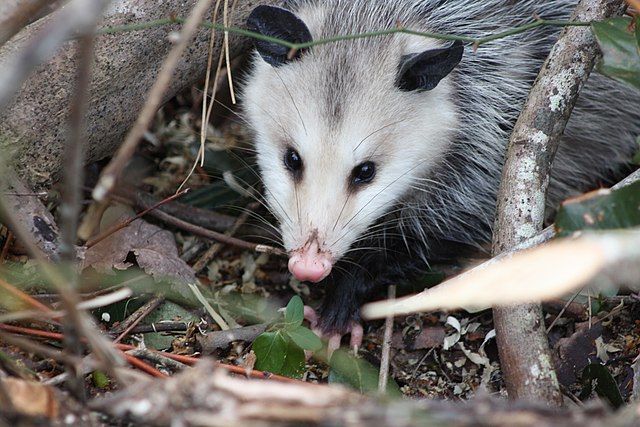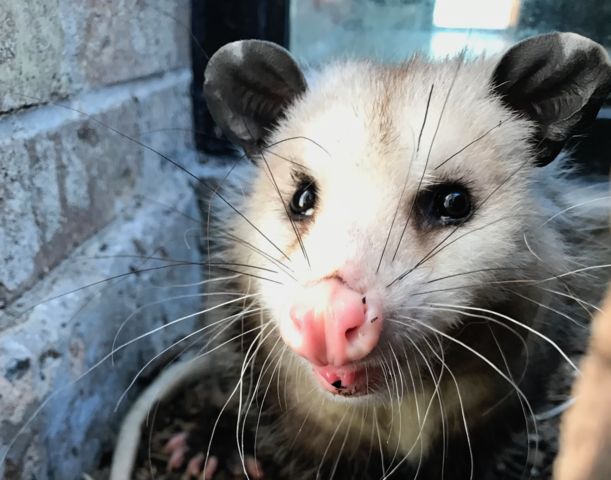Possums right here in Québec!
It’s somewhat cute yet somewhat odd-looking. Have you seen this mysterious little creature in your neighbourhood? Grey fur, black ears and black paws, pink fingers, and a pointy white snout… it’s not a rat, it’s not a racoon… so what is it? Meet the Virginia opossum — usually called possum for short! Yes, we know what you’re going to ask now: “What are Virginia opossums doing here?” Great question. Less than twenty years back, running into these animals in our part of the continent was rare but sightings are getting more common now. How come? You guessed it: climate change. Let’s look at why that is.

A North American Marsupial
The Virginia opossum (whose scientific name is Didelphis virginiana) is the only marsupial species found north of Mexico. Marsupials are mammals whose offspring stay in a “pouch” on the mother’s tummy after they are born. Marsupials belong to the same group as, you guessed it, kangaroos! Newborn possums are kept warm in their mother’s pouch for 50 to 65 days before they start to come out to explore the world, and with reason! They only measure about 14 millimetres when they’re born. It’s only once they reach the age of 15 weeks that they can start fending for themselves.
Possums are solitary animals. You’ll often find them near waterholes, like ponds or marshes. They eat whatever they can get their hands on, a lot like racoons but with one exception; unlike those irrepressible trash bandits, possums are far from being as brave. In fact, when they get too scared, they are famous for playing dead. That’s where the expression “playing possum” comes from!

Where Do North American Possums Live Exactly?
Possums don’t do well in cold weather and tend to live in places where temperatures are warmer. Originally, possums were native to Mexico and parts of Central America and could sometimes be found just south of the Canadian border. Over time, due to climate change, average temperatures in Québec and elsewhere in Canada have been on the rise. Temperatures are also rising further south where possums are normally found. If this keeps up, these southern areas will become too warm for them, which will make living further north in Canada more and more attractive for possums.
Possums are already on the move towards the north. Curious about where you might be most likely to spot one in Québec? For now, they have been spotted mainly on Montréal’s South Shore and in the Eastern Townships. The very first sightings in the province date back to 1976, but local possum populations are now well established. Their numbers have been on the rise since 2000. In 2017, some were spotted near Trois-Rivières, which is further north than Montréal and on the north side of the St. Lawrence.

What Should You Do If You Meet a Possum?
If you run into a possum, keep in mind that it is a wild animal. You already know that trying to touch or to catch a squirrel is a bad idea, right? Same goes for a fox, a wild ferret, and possums too! The best strategy is to just leave them be! Do you leave food outside for any of your pets? Make sure you don’t leave any outside overnight. That food might end up as the possum’s dinner instead!
Possums and Diseases: Fact or Myth?
There are a few myths when it comes to these marsupials. One of them says that possums can help control the spread of Lyme disease, a neurodegenerative condition humans get from ticks. It’s true that possums are quick to detect and remove parasites from their fur because they regularly groom themselves, but this does not mean that they catch them all. Neither does it mean that they are reducing the number of ticks in the area — and certainly not to the extent where they can contain Lyme disease in any significant way. If you think attracting possums near your home might help keep ticks away, think again. This is a myth.
Maybe you’ve heard that a possum bite can give you rabies. Getting rabies from a possum isn’t impossible, but possums with rabies are rare and even more so in more northern places like Canada. Still, if you ever get bitten by a possum, make sure to get yourself to a doctor anyway!
Even though we just finished talking about possum bites, you should know that possums are generally shy and harmless creatures. If you spot one, don’t be scared! Check out their cute little face from afar and if you want to reach out and pet it, do it with your eyes, not your hands!
Check out more articles and subscribe to the blog at the bottom of this page!
Sources
- Deb, J. C., Forbes, G., & MacLean, D. A. (2020). Modelling the spatial distribution of selected North American woodland mammals under future climate scenarios. Mammal Review, 50(4), 440‑452. https://doi.org/10.1111/mam.12210
- Gouvernement du Québec. (2021). Opossum d’Amérique et maladie de Lyme : Mythe et réalité. Gouvernement du Québec. https://www.quebec.ca/nouvelles/actualites/details/opossum-amerique-maladie-lyme-mythe-realite
- Kimmett, C. (2015). The Critters In Your Backyard Aren’t Who They Used To Be. HuffPost. https://www.huffpost.com/archive/ca/entry/climate-change-animals_n_8565458
- MacLellan, A. (2022, avril 16). More opossums popping up on Montreal’s South Shore | CBC News. CBC. https://www.cbc.ca/news/canada/montreal/opossums-quebec-1.6419823
- McManus, J. J. (1974). Didelphis virginiana. Mammalian Species, 40, 1‑6. https://doi.org/10.2307/3503783
- McRuer, D. L., & Jones, K. D. (2009). Behavioral and Nutritional Aspects of the Virginian Opossum (Didelphis virginiana). Veterinary Clinics of North America: Exotic Animal Practice, 12(2), 217‑236. https://doi.org/10.1016/j.cvex.2009.01.007
- Walsh, L. L., & Tucker, P. K. (2018). Contemporary range expansion of the Virginia opossum ( Didelphis virginiana ) impacted by humans and snow cover. Canadian Journal of Zoology, 96(2), 107‑115. https://doi.org/10.1139/cjz-2017-0071
- Williams, C. M., Henry, H. A. L., & Sinclair, B. J. (2015). Cold truths : How winter drives responses of terrestrial organisms to climate change. Biological Reviews, 90(1), 214‑235. https://doi.org/10.1111/brv.12105
